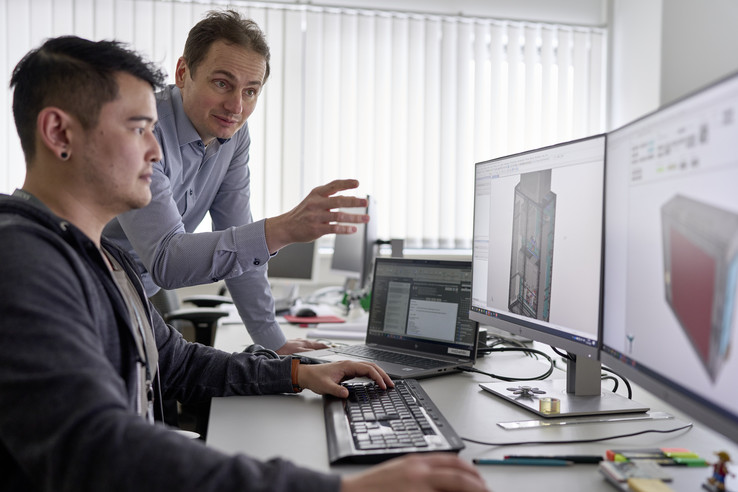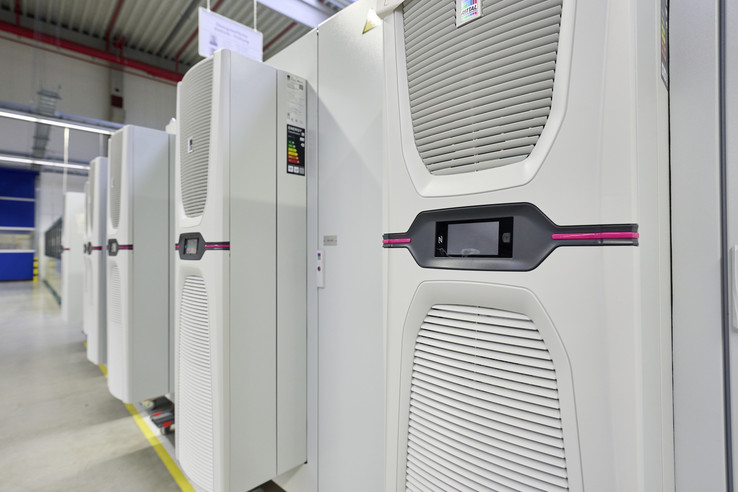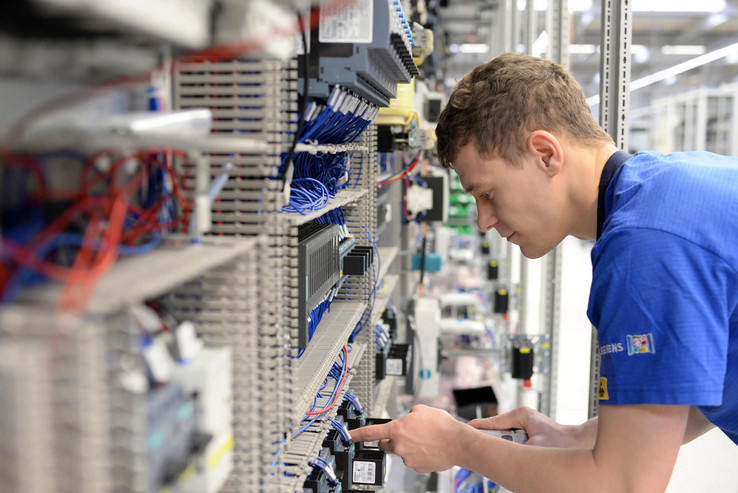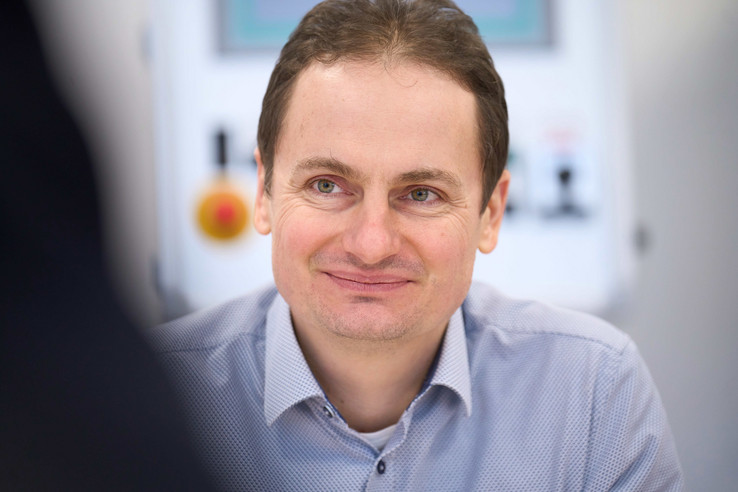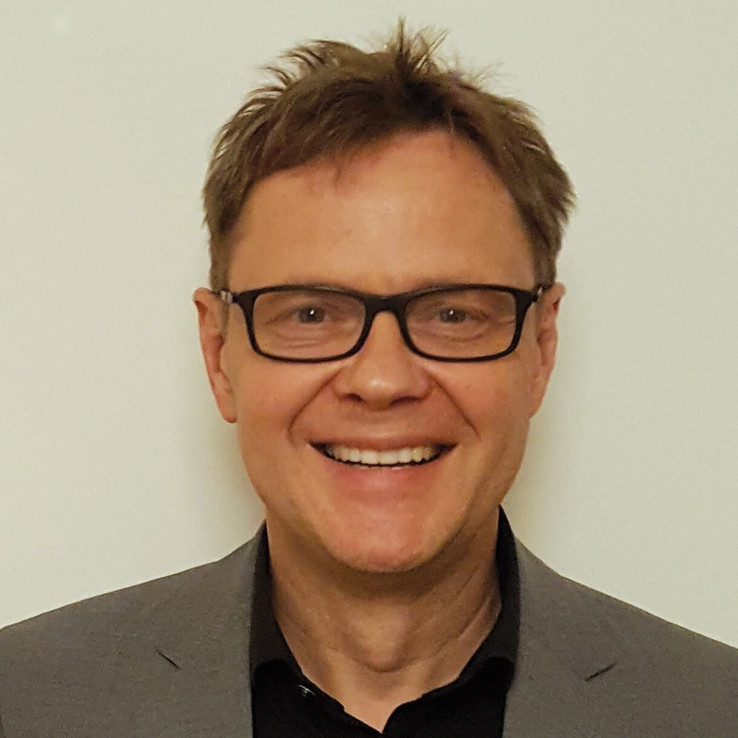Perfect Network Integration – Directly from Design to Production
Digital twin as an enabler for batch size 1
Around 21,000 control cabinets and 29,000 small enclosures are produced here annually – the majority of which are unique. The Chemnitz-based company was quick to standardization and the digital twin, which always provides an image of the real enclosure. Together with EPLAN and Rittal, the company has resolved the contradiction between automation and batch size 1.
Anyone looking down from the gallery onto the shop floor at Siemens WKC –almost a bird’s-eye view – has an impressive vista below them. Among the plethora of control cabinets across a vast area, scarcely a single one is mass-produced or a simple variation. Instead, these are unique, one-off products, designed to customer requirements from the very start and now manufactured in the same manner.
How can such a diversity of products be managed? And how has this helped Siemens WKC to maintain its position as the European market leader in control cabinet manufacturing for machine tools for so many years? It becomes clear after talking with Hans-Peter Kasparick and Mirko Löffler, the architects of digital workflow and manufacturing engineering at Siemens WKC.
Anyone looking down from the gallery onto the shop floor at Siemens WKC –almost a bird’s-eye view – has an impressive vista below them. Among the plethora of control cabinets across a vast area, scarcely a single one is mass-produced or a simple variation. Instead, these are unique, one-off products, designed to customer requirements from the very start and now manufactured in the same manner.
How can such a diversity of products be managed? And how has this helped Siemens WKC to maintain its position as the European market leader in control cabinet manufacturing for machine tools for so many years? It becomes clear after talking with Hans-Peter Kasparick and Mirko Löffler, the architects of digital workflow and manufacturing engineering at Siemens WKC.
Standardisation and digitalisation
The reason for the company’s efficiency and very competitive position in control cabinet customisation can be summarised simply in a single sentence: Siemens WKC got a very early start – almost twenty years ago – on standardising the process of control cabinet design and manufacture and using the data to create a digital twin: the digital image of the physical control cabinet. This process basically starts with the transfer of the customer’s data into a standardised format. Siemens WKC Digital Strategy and Innovation Manager Hans-Peter Kasparick explains: “We’ve developed our own data model based on EPLAN Electric P8 and EPLAN Pro Panel – simply because our customers in general mechanical engineering predominantly work with EPLAN. Today, there is still a lot of data that needs to be collected manually due to media discontinuities. At ZVEI [Germany’s Electro and Digital Industry Association], we’re discussing the automation of cross-company data exchange – with the semantics of ECLASS Advanced and a standardised database structure ‘management shell concept’.”
A focus on the digital twin
During the production process, the digital twin continues to be enhanced and completed with production data, PCF values, export data, and so on and can be delivered to the customer along with the actual product. This offers advantages at all levels of planning, design and manufacturing that Siemens WKC covers – from suppliers (for preassembled cables, for instance) to the use of the data throughout the control cabinet’s entire life cycle.
The advantages of standardisation
The effort required to standardise the data at the start of every project may be greater than simply using and enhancing the existing data set. However, this effort is more than worth it as the process continues through engineering and manufacturing. Segment Manager for Manufacturing Engineering Mirko Löffler explains: “The digital twin must be independent of the system used to create it or process it. We have to standardise the data exchange so that every engineering tool can contribute to efficient data creation while at the same time the various factories, all of which have very different equipment, are able to utilise the created data.” Ultimately it is also Siemens WKC’s customers who benefit – with faster throughput times, higher quality and prices in line with the market: “Moreover, our clients are getting added value in engineering and in manufacturing.”
Direct connection to production systems
A closer look at control cabinet production demonstrates the specific value of such a data model on the shop-floor level at Siemens WKC. Mirko Löffler: “The production data is generated automatically from the digital twin even as it is being used in the production process – with the drilling and milling systems, for laser processing, and in cable assembly. The digital and real worlds are directly connected here and we’ve created interfaces to achieve this. This is also the case, for example, when the equipment is tested at the end of production.”
An integrated concept
Flexibility also always plays an important role when data is digitalised at Siemens WKC. As Mirko Löffler explains, the digital twin must also remain unaffected by, for instance, whether a person or a robot does the work or which machine must be controlled: “We don’t just have raw data that we can manage quite well, we also have interfaces to all kinds of standards and machines. This allows us to work with quite a bit of flexibility. It also helps us to keep the added-value steps separate, as in the way we’ve implemented them at our digital assembly station with integrated 3D laser navigation.”
Good interchange with EPLAN and Rittal
In mechanical production, the control cabinet is prepared using EPLAN Pro Panel and processed using machines from Rittal. Mirko Löffler: “We were the first to use the Perforex machines with control systems from Siemens.” Furthermore, Siemens WKC recently ordered a Rittal 3D laser machining system.
However, the relationship between the three companies is not limited to the delivery of hardware and software. Siemens WKC also maintains close contact with EPLAN and Rittal to bounce off ideas and for planning the next steps in the company’s automation and digitalisation. Hans-Peter Kasparick: “Rittal and EPLAN are essential partners for us since they are intensively working on promoting solutions for control cabinet and switchgear manufacturing – on the software side of things, on related products as well as on automation solutions and machines. That is why they are our preferred suppliers and innovation partners. We take up ideas that they develop to market maturity. We learn from one another, complement each other and exchange ideas.” Mirko Löffler adds: “We naturally also have regular, extensive discussions with our customers from the mechanical engineering and plant system engineering sectors. We provide and receive impulses and ideas that help both sides move forward.”
Perspective: Further automation – and opening up new target industries
With the most extensive standardisation and end-to-end data consistency, not to mention the data’s direct transfer to production, Siemens WKC sees itself well positioned to further expand its leading market position. The benefits of the digital twin are clear to see. Using this concept, the company will continue to implement further automation steps and also tap into new markets. Hans-Peter Kasparick: “Climate-neutral energy management and mobility that reduces carbon-dioxide emissions are opening up new groups of customers for us.
Energy needs to be distributed everywhere, sensors and actuators must be connected, and it is all best done at one central point, in the control cabinet. Only with efficient cross-company collaboration will we be able to tap this potential over the coming years. This involves joint standardisation and the further development of digital information exchange. Here is where we want and need to do some convincing – as WKC, but also in ZVEI, on other committees and with our more than 200 active clients.”



